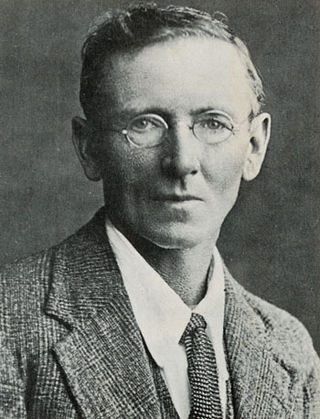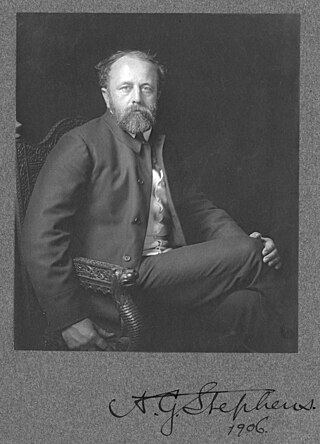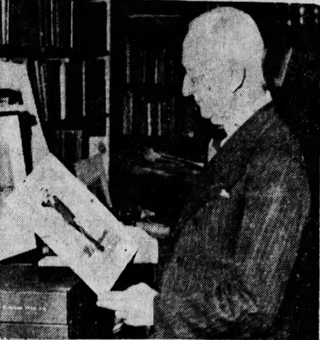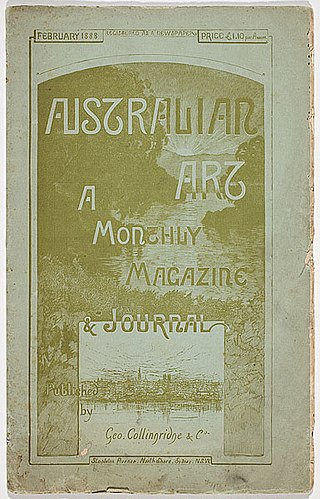
The Bookfellow was a monthly English-language journal published in Sydney, New South Wales, Australia. The publication's focus was Australian literature [1] and editions were often accompanied by illustrations. [2]

The Bookfellow was a monthly English-language journal published in Sydney, New South Wales, Australia. The publication's focus was Australian literature [1] and editions were often accompanied by illustrations. [2]
The Bookfellow was published in Sydney, by William Macleod from January 1899 to May 1899. [3] Journalist A. G. Stephens, one of Australia’s most influential critics, had made several attempts at producing a literary magazine for Australians. In 1894, he was recruited by J. F. Archibald for the weekly Bulletin. He claimed the inside cover of the magazine for reviewing books and relaying literary gossip to interested readers. This section of the Bulletin came to be known as the ‘Red Page.’ [4]
Stephens assisted many emerging Australian writers by featuring their work on the ‘Red Page.’ In 1898, he convinced the owners of The Bulletin to sponsor a small magazine to increase the scope of the ‘Red Page.’ In January 1899, the first issue of The Bookfellow was published. [4]
The magazine actively promoted Australian writing and set out to educate Australian readers about developments in literature occurring overseas. The first issue, was subtitled ‘A monthly Magazine for Book Buyers and Book-Readers.’ [4]
Those who wrote for the publication included Barcroft Boake, Christopher Brennan, Mary Hannay Foott, A. G. Stephens and A. J. Fischer. [5]
The magazine ceased after 5 issues, in May 1899. Stephens returned to the ‘Red Page,’ but following a souring of his relationship with new Bulletin editor, James Edmonds, Stephens left The Bulletin in November 1906 to open a small bookshop that he called "The Bookfellow." He resurrected The Bookfellow as a weekly magazine in January 1907; however, neither the bookshop, nor the magazine would see the year out. [4]
The Bookfellow was revived again in the 1920s and ceased finally in 1925, but continued to operate as a publisher of books into the 1930s.
The journal has been digitised in Trove [2] by the National Library of Australia [6]

The Bulletin was an Australian weekly magazine first published in Sydney on 31 January 1880. The publication's focus was politics and business, with some literary content, and editions were often accompanied by cartoons and other illustrations. The views promoted by the magazine varied across different editors and owners, with the publication consequently considered either on the left or right of the political spectrum at various stages in its history. The Bulletin was highly influential in Australian culture and politics until after the First World War, and was then noted for its nationalist, pro-labour, and pro-republican writing.

Jules François Archibald, known as J. F. Archibald, baptised John Feltham Archibald,, Australian journalist and publisher, was co-owner and editor of The Bulletin during the days of its greatest influence in Australian politics and literary life. He was also the founder and namesake of the annual Archibald Prize art award.

John Shaw Neilson was an Australian poet. Slightly built, for most of his life he worked as a labourer, fruit-picking, clearing scrub, navvying and working in quarries, and, after 1928, working as a messenger with the Country Roads Board in Melbourne. Largely untrained and only basically educated, Neilson became known as one of Australia's finest lyric poets, who wrote a great deal about the natural world, and the beauty in it.

The Royal Australian Historical Society, formerly Australian Historical Society, is a voluntary organisation founded in Sydney, Australia in 1901 with Andrew Houison as founding president. Its goals are to encourage the study of and interest in Australian history. It has a membership throughout Australia and many of its activities and facilities are funded by contributions from its members and benefactors.

Alfred George Stephens, commonly referred to as A. G. Stephens, was an Australian writer and literary critic, notably for The Bulletin. He was appointed to that position by its owner, J. F. Archibald in 1894.
Michael Sharkey is an Australian poet, resident in Castlemaine in the goldfields region of Victoria.

William Macleod, was an Australian artist and a partner in The Bulletin. He was described as generous, hospitable, a 'big man with a ponderous overhang of waistfront, a trim, grey beard, the curling moustachios of a cuirassier, and brown, kindly eyes gleaming through his spectacles'.
Chance International was a men's magazine founded in Sydney in 1966 by Gareth Powell Associates, which was basically Gareth Powell in association with Jack de Lissa. It used Playboy and Penthouse magazines as a model, creating a magazine that Australia had not seen before with both pictures of beautiful unclothed ladies and articles worth reading. The magazine was originally printed in Australia with the Griffin Press in Adelaide but almost immediately switched to Hong Kong as high quality printing at an affordable price was not then available in Australia.

The Sydney Mail was an Australian magazine published weekly in Sydney. It was the weekly edition of The Sydney Morning Herald newspaper and ran from 1860 to 1938.
Larry Philip Buttrose is an Australian writer, journalist and academic. He is the ghostwriter of the Saroo Brierley memoir A Long Way Home.

Australian Town and Country Journal was a weekly English language broadsheet newspaper published in Sydney, New South Wales, from 1870 to 1919. The paper was founded by Samuel Bennett with his intention for it to be "valuable to everybody for its great amount of useful and reliable information".
Table Talk: A Journal for Men and Women, was a weekly magazine published from 26 June 1885 until September 1939 in Melbourne, Australia. It was established in 1885 by Maurice Brodzky (1847–1919), who obtained financial assistance to start his own publication after resigning from The Herald.
Pacific Islands Monthly, commonly referred to as "PIM", was a magazine founded in 1930 in Sydney by New Zealand born journalist R.W. Robson.
The Transcontinental is a weekly newspaper published in Port Augusta, South Australia which dates from October 1914. It was later sold to Rural Press, previously owned by Fairfax Media, but now an Australian media company trading as Australian Community Media.

James Robert Tyrrell was an Australian bookseller, art dealer, publisher and author. He enjoyed a career of seven decades in the booktrade and was esteemed in his era as the "doyen of Sydney booksellers". He wrote a standard history of early bookselling in Australia entitled Old Books, Old Friends, Old Sydney.
The Adelaide Chronicle was an early publication in Adelaide, the capital of the then colony of South Australia. It was published between 1839 and 1842, when it ceased publication as a result of the economic depression caused by the mass exodus of workers to the Victorian goldfields.

Australian Art: a Monthly Magazine & Journal, was a monthly magazine published in Sydney, Australia. The publication's focus was to chronicle the progress of the fine arts in the Australasian colonies. Issues also included artist-proof engravings.
Wolla Meranda was an Australian novelist, journalist, editor, and artist.

The Chinese Times was a Chinese language newspaper established in Melbourne in 1902. Its Chinese title was initially 愛國報 Aiguobao, later 警東新報 Jingdongxinbao (1905-1914), 平報 Pingbao (1917), 民報 Minbao. At the time of its establishment it was the only Chinese-language newspaper in Melbourne, and one of three in Australia. From 1919 it was the official newspaper of the Kuomintang in Australia. It moved to Sydney in 1922, where it continued to publish until 1949.
aCOMMENT was an early Australian modernist avant-garde literary "little magazine" of the 1940s published in Melbourne by Cecily Crozier. It ran to twenty-six, mostly quarterly, issues from 1940 to 1947.